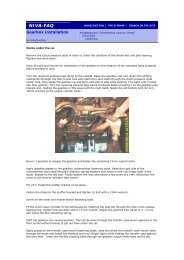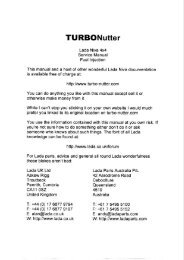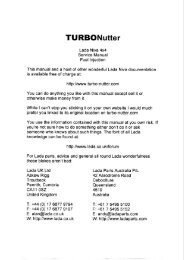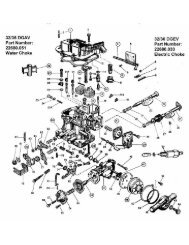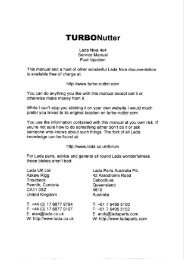WEBER CARBURETOR TROUBLESHOOTING GUIDE - Niva Manuals
WEBER CARBURETOR TROUBLESHOOTING GUIDE - Niva Manuals
WEBER CARBURETOR TROUBLESHOOTING GUIDE - Niva Manuals
Create successful ePaper yourself
Turn your PDF publications into a flip-book with our unique Google optimized e-Paper software.
<strong>WEBER</strong> <strong>CARBURETOR</strong><br />
<strong>TROUBLESHOOTING</strong> <strong>GUIDE</strong><br />
5 <strong>CARBURETOR</strong><br />
Do the following steps only after you have completed 1A, 2A, 3A and 4A.<br />
This will help you save time and avoid creating any secondary problems.<br />
In our experiences most problems initially thought to be carburetor problems<br />
are those caused by other engine components.<br />
A. Testing the choke and the throttle linkage:<br />
Check that you have free movement at the carburetor with an assistant operating<br />
the gas pedal. In our experiences over tightened throttle shafts contribute to<br />
many carburetor problems.<br />
B. Testing the Idle Speed Adjustment:<br />
With the engine at normal operating temperature, adjust to manufacturers<br />
specs: turn adjustment screw in (clockwise) to raise the speed and out (counterclockwise)<br />
to lower).<br />
C. Testing the Fast Idle Adjustment:<br />
It may be necessary to perform this test first thing in the morning or after the<br />
vehicle has been allowed to cool down.<br />
With the engine cold, press the gas pedal to the floor once and release.<br />
Start Vehicle. Engine speed should be 2000 RPM - 2500 RPM after about<br />
10 seconds. Turn engine off. To adjust turn fast idle screw in to increase<br />
fast idle speed and out to decrease. Do not disturb the carburetor linkage<br />
during this adjustment. Without touching the gas pedal start engine again<br />
check engine RPM. If you have to readjust use the procedure above .<br />
D. Testing the Automatic Choke adjustment.<br />
The choke is preset at the factory but in some cases it may be necessary<br />
to readjust.<br />
The choke assembly must be cool ( below 68 F 20C) before attempting to<br />
make any adjustments. First fully rotate the throttle lever and release;<br />
Check for smooth operation; the choke plate should be all the way closed.<br />
Make a reference mark on the carburetor and the choke where the two faces<br />
meet. Loosen the three 7mm hex head screws one full turn. While holding<br />
the throttle about one third open, adjust the closing tension on the choke<br />
plates just fully close; then slightly increase the tension on the spring by<br />
continuing to rotate the thermostat 1/8" measured in the outer diameter of the<br />
thermostat. Tighten the three 7mm hex head screws without distorting the<br />
retainer ring; fast idle speed my need to be readjusted. If the choke plates<br />
do not fully open after running the engine for three minutes go to step 5E<br />
E. Testing the choke thermostat assembly<br />
The electric choke terminal must have a key hot 12 volt source.<br />
The carburetor is grounded to the engine by a metal to metal connection.<br />
If the vehicle was originally equipped with an electric choke and or an idle<br />
solenoid use that wire. If you do not have a wire present , splice into the wire<br />
leading from the ignition switch to the coil or ballast resistor.<br />
Water chokes must have a free flow of engine coolant.<br />
F. Testing the idle cut-off solenoid (if equipped)<br />
With the solenoid on the carburetor and ignition on and engine off,<br />
disconnect the wire from the solenoid and listen for a click; then with the<br />
engine idling, disconnect the wire leading to the solenoid. The engine should<br />
stop. If the engine does not stop the solenoid is likely defective.<br />
Page 5





